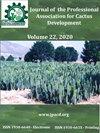阿尔及利亚两个地区几种刺麻属植物的鉴定及其酚类化合物的超声提取
IF 0.4
4区 农林科学
Q4 HORTICULTURE
Journal of the Professional Association for Cactus Development
Pub Date : 2021-06-29
DOI:10.56890/jpacd.v23i.320
引用次数: 1
摘要
仙人掌因其独特的特性而备受关注。在世界各地的干旱和半干旱地区,都发现了无公害的榕树(Opuntia ficus-indica)及其相关种。榕树在对环境条件的反应中表现出相当大的变异性,通过改变乳晕和脊柱属性,以及其他特征。因此,本研究试图对阿尔及利亚两个地区(Bejaia和Souk-Ahras)的一些仙人掌梨植物进行形态学鉴定,通过优化枝状花序中酚类化合物的提取条件,评价这些化合物的抗氧化活性,测定总黄酮含量,并比较3种仙人掌属植物(O. ficus-indica, O. megacantha和O. amyclae)在研究区域内的产量。分别采用常规提取法和超声辅助提取法对三种食材进行了多酚提取。提取完成后,对提取物的总酚含量和总黄酮进行了表征。此外,测定了总酚类化合物(TPC)的抗氧化能力。UAE法对TPC的回收效果优于常规提取法。采用50%水/乙醇(v/v)的混合溶剂提高了TPC的提取效率。这些结果表明,UAE是提取仙人掌、梨枝中植物化学物质的有效工具。还需要研究影响TPC提取优化的其他因素和条件,如pH、超声频率以及可能影响提取效率的生态因素。本文章由计算机程序翻译,如有差异,请以英文原文为准。
Identification of some Opuntia spp. from two Algerian regions and ultrasound-assisted extraction of their phenolic compounds
Much attention has been paid to cacti for their distinctive characteristics. The nopal Opuntia ficus-indica and related species are found in arid and semi-arid regions around the world. O. ficus-indica shows considerable variability in response to environmental conditions through variation of areola and spine attributes, among other traits. Therefore, the present study sought to morphologically identify some cactus pear plants in two areas of Algeria (Bejaia and Souk-Ahras) in order to evaluate the cactus pears by optimizing the extraction conditions of the phenolic compounds of the cladode, to evaluate the antioxidant activity of these compounds, to measure the total flavonoid content, and to compare the yields among three Opuntia spp. (O. ficus-indica, O. megacantha and O. amyclae) from the sites within the study regions. These three Opuntia spp. were subjected to extraction of polyphenols using a conventional method, and an ecofriendly process using ultrasound-assisted extraction (UAE) technique. Once the extractions was completed, the total phenolic content and flavonoids of the extracts were characterized. In addition, the antioxidant capacity of the total phenolic compounds (TPC) was determined. The UAE was better than conventional extraction for the recovery of TPC. The use of a solvent mixture (50% water/ethanol, v/v) improved the TPC extraction efficiency. These results show that UAE was a useful tool for the extraction of phytochemicals from cactus pear cladodes. Other factors and conditions that influence the optimization of TPC extraction should also be studied, such as pH, ultrasound frequency as well as ecological factors that could possibly influence extraction efficiency.
求助全文
通过发布文献求助,成功后即可免费获取论文全文。
去求助
来源期刊

Journal of the Professional Association for Cactus Development
Agricultural and Biological Sciences-Plant Science
CiteScore
1.10
自引率
33.30%
发文量
10
期刊介绍:
The editors of the Journal of the Professional Association for Cactus Development, are very excited to be a part of the excellent editorial committee and to work together to create the synergism between scientists, growers, legislators, and business people so vital to the development of this industry to serve the people of arid lands.
 求助内容:
求助内容: 应助结果提醒方式:
应助结果提醒方式:


